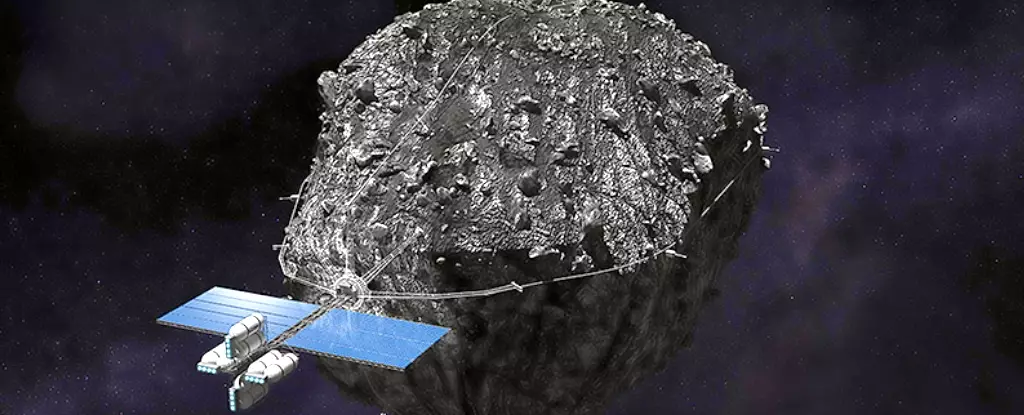Asteroid mining, once confined to the realm of science fiction, has increasingly garnered attention as a tangible venture driven by the promises of enormous wealth and resources located billions of kilometers away. However, the suggested valuations and feasibility often come under scrutiny. At the center of this conversation is Psyche, the metallic asteroid thought to be worth a staggering $10 quintillion—numbers that dazzle, but raise questions regarding their authenticity and practical implications. Recent studies attempt to peel back the layers of this proposition, examining not only the economic viability but also the viability of extracting materials from these celestial bodies.
The Real Value of Asteroids: A Closer Look
In the pursuit of understanding the economics behind asteroid mining, a research paper funded by the asteroid mining start-up Astroforge, in collaboration with a professor from the Colorado School of Mines, serves as an important point of reference. This study categorizes the metals found on asteroids into two primary groups: those that would be valuable if returned to Earth and those designated for in-space construction. The platinum-group metals (PGMs) emerged as the stars of this classification, celebrated for their high market prices and essential roles in various technologies—think of catalytic converters, a target for thieves back on Earth due to their high value.
Conversely, metals that may be useful for structural purposes—like iron and aluminum—prove to be less compelling for journeys back to Earth due to their lower market value. However, their real worth appears when considering the burgeoning industry of space construction. Although extracting these materials may not appear immediately profitable given Earth’s lower prices, the economic calculus changes when these metals are utilized in space-based applications.
Understanding the Pricing Dilemma
Asteroid mining has been likened to mining precious metals in inverse conditions. On Earth, prices hover around $10,000 per kilogram to launch materials into space. In contrast, PGMs can reach astronomical valuations, such as $500,000 per kilogram for elements like rhodium. This prompts speculation. Is it realistic to envision profitable mining operations on asteroids, or are we simply dazzled by theoretical maximums?
Within this complex web of evaluations, the true composition of asteroids plays a pivotal role. Research shows that while previous studies suggested certain asteroids were ‘pure metal,’ this assumption needed reevaluation. A survey of meteorites—which serve as remnants of asteroids—revealed new insights that challenge earlier beliefs about metal concentration.
Meteorite analysis lends itself to more accurate assessments than remote sensing, giving researchers insight into the elemental makeup of asteroids. Notably, the concentration of PGMs in certain residues can be far superior when compared to terrestrial ore deposits. In particular, materials known as refractory metal nuggets (RMNs) may provide metallic concentrations significantly greater than those available on Earth, specifically in L-type asteroids.
L-type asteroids, relatively underexplored due to their rarity, hold great promise. They may harbor compositions where more than 30% of their structure comprises calcium aluminum inclusions (CAIs) that could yield large quantities of PGMs. However, this potential comes with technical challenges as RMNs, given their microscopic size, necessitate advanced extraction techniques to become commercially viable sources.
Processing metals extracted from asteroids for in-space utilization also presents hurdles. Despite the anticipated availability of essential structural metals, these elements often exist in oxidized forms that require sophisticated energy-intensive techniques for separation. The irony in this situation introduces a classical ‘chicken and egg’ dilemma: the infrastructure required to process these metals does not exist yet; its realization would depend on the very metals mined. This circular issue complicates the vision for asteroid mining and its timely development into a practical reality.
With so many uncertainties, companies like Astroforge remain optimistic. By embarking on missions to assess the material composition of near-Earth asteroids, they hope to shed light on the real value of these celestial bodies. The upcoming endeavors will itemize not only the metals available but their economic potential, laying the groundwork for future exploitation.
Asteroid mining stands at a fascinating crossroads where ambition meets scientific inquiry, and as we gear up to delve further into the cosmic bounty above us, the conversation will evolve from mere speculation into strategic decision-making grounded in credible research. As we continue to decode the mysteries of asteroids, only time will tell if these metallic giants can indeed deliver on the glimmering promises they offer.

